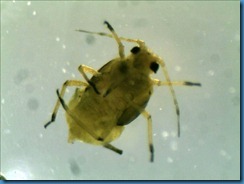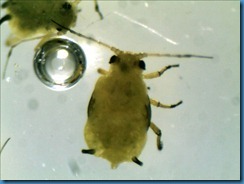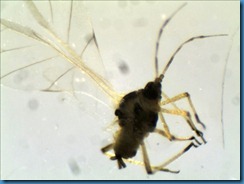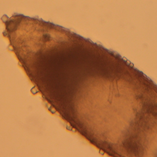My first attempt of insect slide making was not a successfully one but I think the experience worth to share, especially for those DIY hobbyists. I was very excited to find an insect slide making reference published by Schauff from USDA. The Schauff's protocol can be generalized by the following steps:
1) Maceration (cleaning): Using caustic reagents, such as sodium hydroxy, potassium hydroxy, lactophenol or lactic acid , to remove external secretions, foreign matters, some organs, and fat bodies. The purpose is to remove those parts without damaging the chitinous parts. Heating the specimen in the maceration reagent can accelerate the process. 2) Washing: Removing the caustic agents with tap water in a small dish for at least a few minutes. 3) Staining, Bleaching and Dehydration: Staining and bleaching are optional steps to improve the viewing ability of the insect. Stain it, if too light. Bleach it, if too dark. Any residual water in the specimen needs to be removed before mounting - it is not mixable with water. 4) Mounting: Mounting for microscopic examination can be temporary or permanent. temporary slide can be made with acetic acid on a cavity slide. The permanent mount can be done with Canada Balsam, Euparal or Hoyer’s medium and polyvinyl alcohol (PVA).
In this trials, aphids an ants (that protects the aphids) found on my loquat tree were chosen to make the microscope slides because they are readily available from backyard. My protocol adopted Schauff's protocol but slightly modified and using the generally available household chemical. :
1) Maceration: This step is done with 10% sodium hydroxy solution. To make the solution,  I added 1 gram of Roebic heavy duty crystal drain opener (Picture on the Left) in 10 mL tap water. The Roebic Heavy duty crystal drain opener contains 100 percent sodium hydroxy, according to the manufacturer's MSDS.
I added 1 gram of Roebic heavy duty crystal drain opener (Picture on the Left) in 10 mL tap water. The Roebic Heavy duty crystal drain opener contains 100 percent sodium hydroxy, according to the manufacturer's MSDS. 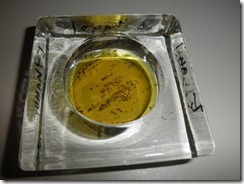 There are other types of drain opener in the home improvement store, but this is the only one contains one hundred percent sodium hydroxy. Candle warmer container is used for the maceration. The sodium hydroxy will gradually turned yellow when it started to digest the insect’s internal organs (Right). I varied the length of maceration from 24 to 72 hours – the longer I left the insects in sodium hydroxy, the more transparent they are.
There are other types of drain opener in the home improvement store, but this is the only one contains one hundred percent sodium hydroxy. Candle warmer container is used for the maceration. The sodium hydroxy will gradually turned yellow when it started to digest the insect’s internal organs (Right). I varied the length of maceration from 24 to 72 hours – the longer I left the insects in sodium hydroxy, the more transparent they are.
2) Cleaning: The insects were picked up by a pair of tweezers and transferred to tap water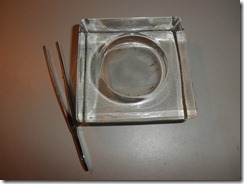 . I gently pipetted the contents to allow sodium hydroxy to be diluted faster. I repeated it for the second time by siphoning up the supernatant. The supernatants were discarded and the insects were left in the in the container. Another 10 to 15 mL tap water was added and repeat the some process. The insects are now partially transparent but still has some contents in the abdomen and thorax.
. I gently pipetted the contents to allow sodium hydroxy to be diluted faster. I repeated it for the second time by siphoning up the supernatant. The supernatants were discarded and the insects were left in the in the container. Another 10 to 15 mL tap water was added and repeat the some process. The insects are now partially transparent but still has some contents in the abdomen and thorax.
3) Dehydration and more cleaning: This step is done by Crown Denatured Alcohol Next which contains about 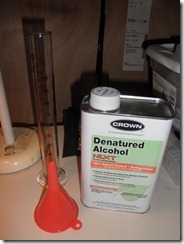 95 percent ethanol (The rest of the ingredient is isopropanol) – Crown has another denatured alcohol contains methanol. I like the one labeled as “Next” and “95 Percent nature content” because ethanol is less toxic. Again, I siphoned water from the cleaning solution and left the insects in the candle holder then added 10 to 15mL denatured alcohol. The container of alcohol wasn’t helping me to pour the alcohol out. I used the funnel to help but it still got messy.
95 percent ethanol (The rest of the ingredient is isopropanol) – Crown has another denatured alcohol contains methanol. I like the one labeled as “Next” and “95 Percent nature content” because ethanol is less toxic. Again, I siphoned water from the cleaning solution and left the insects in the candle holder then added 10 to 15mL denatured alcohol. The container of alcohol wasn’t helping me to pour the alcohol out. I used the funnel to help but it still got messy. 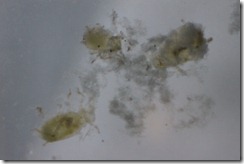 The insects were left in alcohol for about 30 minutes then I started the cleaning. This time was the internal organs of the insects. There are still plenty of contents resided in the exoskeleton of the insects and surrounded the carcasses – I believed that they were denatured proteins an nucleic acids which were precipitated out then I added alcohol. I cleaned them up with a pair of picks. I siphoned the cleaned insects up and transferred it to a different container containing the denatured alcohol. I did more cleaning after the transfer to remove any protein and nucleic acid residues (right).
The insects were left in alcohol for about 30 minutes then I started the cleaning. This time was the internal organs of the insects. There are still plenty of contents resided in the exoskeleton of the insects and surrounded the carcasses – I believed that they were denatured proteins an nucleic acids which were precipitated out then I added alcohol. I cleaned them up with a pair of picks. I siphoned the cleaned insects up and transferred it to a different container containing the denatured alcohol. I did more cleaning after the transfer to remove any protein and nucleic acid residues (right).
4) Mounting: The insects were siphoned up and transferred to a microscope slide. I tried to picked up as little alcohol as possible so that the alcohol won’t spill over or messed up the insects already on the slide (Several insects were mounted on the same slide and in different position). The position and the posture of the insects were manipulated with picks to optimized the viewing – extending legs, minimized the wrinkles, changed orientations, making the posture natural etc. A few drops of clear fingernail polish top code were added to the slide to cover the insects. A cover slip was placed on the top to finish the mounting. I waited overnight to allow the finger nail polish to harden before viewing on the microscope.
The following are the pictures from the insect slides made from this experiment: Because this was my first attempt to make insect slides, it’s an trial and error process, not all pictures are using the same condition. In the future post, I will summarize the process and post the optimized condition. For example: Some slides were made with 24 hours of maceration, it tends to show more internal organs and less transparent. The aphid body tends to show better skeleton when they were processed with longer maceration. They also varied with degree of cleaning. The aphid bodies contain lots of fluids and rich in protein. They tend to become less transparent when immerged in alcohol,. The body contents needs to be squeezed out with a pair of picks. Some specimens were not cleaned too well which leaved body parts in the specimen while others were cleaned very well but the extensive cleaning caused the body to be broken apart.
The ants seem to be easier to process then the aphids because of harder exoskeleton. They don’t disintegrated like the aphid’s body do. They don’t have lots of body fluids. This makes the cleaning much easier then the aphids.
Some suggestions about insect slide making:
- The protocols can varied among different insects. Some insects have harder exoskeleton and can resist harsher processing condition while other were softer which required gentler processing condition. For example, some insect can allow to be boiled in NaOH solution while others can only left in room temperature overnight. Some required extra physical cleaning while others can only resist chemical cleaning. The body size can also determine how much processing time. Some insects are so big that you need to punch a hole between segments to allow reagent to penetrate.
- To accelerate the maceration process, some gentle heating might be required (Note: if you are heating the NaOH, make sure that you used a container that can allow direct heating. The candle holders used in this experiment are not. I actually blow up a candle holder by putting it on the top of the 900 W outdoor food warmer! An electronic candle warmer might be used.)
- If you need to squeeze out the body content, do it during cleaning step rather than dehydration step. This will minimized the amount of body fluid denatured in the alcohol – less cleaning.
- Use siphon suck up the insect along with some liquid that the insects are in. This might work better than tweezers or picks, especially after you squeeze the body content out. The body is very fragile.
- Take your time. Be patient and gentle.
- Use Canada balsam if available – I think this is give or take. The advantage of using Canada balsam is the color less and less shrinking than finger nail polish top coat but it required Xylene for dehydration. Xylene is very toxic. While the finger nail polish shrink a lot but you can put insect in ethanol directly in finger nail polish top coat without any problem.
- Use concaved slides or build some wall on the slide to allow more depth if you are doing the whole insect mount.
Reagents, contains and tools can be found in your home. If not, they can be easily found in the home improvement stores (such as Lowes or Homedepot), dollar stores or grocery stores. I’ve found many of these can be found at Amazon.com. (The only thing that I could not find there is the Crown denatured alcohol (which contains 90-95% Ethanol and 5-10% isopropanol. Amazon only has reagent grade ethyl alcohol.).
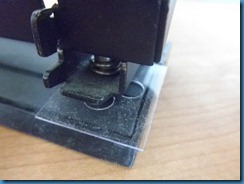 The first step was to cut a piece of plastic to the size slightly smaller than the slide but larger than the cover slip. The next is to make some holes with hole puncher – can be purchased from regular office supply store. Apply some finger nail top coat on one side of the plastic. Glue it to the slide and wait until it dried. Pick up the insects from the preservation alcohol then transfers them to the well with a pair of tweezers. Use the pick to adjust the body orientation and appendages to show their natural position. Put a few drops of finger nail polish top coat in each well until it slightly over the top of the plastic. Care should be taken to ensure that no bubble is introduced into the mountant. Any bubble introduced into the mountant will be enlarged after the mountant dried out.
The first step was to cut a piece of plastic to the size slightly smaller than the slide but larger than the cover slip. The next is to make some holes with hole puncher – can be purchased from regular office supply store. Apply some finger nail top coat on one side of the plastic. Glue it to the slide and wait until it dried. Pick up the insects from the preservation alcohol then transfers them to the well with a pair of tweezers. Use the pick to adjust the body orientation and appendages to show their natural position. Put a few drops of finger nail polish top coat in each well until it slightly over the top of the plastic. Care should be taken to ensure that no bubble is introduced into the mountant. Any bubble introduced into the mountant will be enlarged after the mountant dried out.